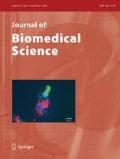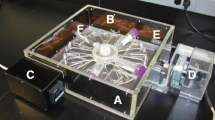Abstract
There is a concern over the potential use of radioactive isotopes as a weapon of terror. The detonation of a radiation dispersal device, the so-called “dirty bomb” can lead to public panic. In order to estimate risks associated with radiation exposure, it is important to understand the biological effects of radiation exposure. Based on this knowledge, biomarkers to monitor potentially exposed populations after a radiological accident can be developed and would be extremely valuable for emergency response. While the traditional radiation exposure biomarkers based on cytogenetic assays serve as standard, the development of rapid and noninvasive tests for radiation exposure is needed. The genomics based knowledge is providing new avenues for investigation. The examination of gene expression after ionizing radiation exposure could serve as a potential molecular marker for biodosimetry. Microarray based studies are identifying new radiation responsive genes that could potentially be used as biomarkers of human exposure to radiation after an accident.
Similar content being viewed by others
References
Unterweger MP, Pibida LS (2005) Advances in radiation detection technologies for responders. Health Phys 89:485–487
Goans RE, Waselenko JK (2005) Medical management of radiological casualties. Health Phys 89:505–512
Moulder JE (2004) Post-irradiation approaches to treatment of radiation injuries in the context of radiological terrorism and radiation accidents: a review. Int J Radiat Biol 80:3–10
Oftedal P (1991) Biological low-dose radiation effects. Mutat Res 258:191–205
Breen AP, Murphy JA (1995) Reactions of oxyl radicals with DNA. Free Radic Biol Med 18:1033–1077
Szumiel I (2008) Intrinsic radiation sensitivity: cellular signaling is the key. Radiat Res 169:249–258
Valerie K, Yacoub A, Hagan MP, Curiel DT, Fisher PB, Grant S, Dent P (2007) Radiation-induced cell signaling: inside-out and outside-in. Mol Cancer Ther 6:789–801
Lobrich M, Jeggo PA (2007) The impact of a negligent G2/M checkpoint on genomic instability and cancer induction. Nat Rev Cancer 7:861–869
Weinfeld M, Rasouli-Nia A, Chaudhry MA, Britten RA (2001) Response of base excision repair enzymes to complex DNA lesions. Radiat Res 156:584–589
Bailey SM, Bedford JS (2006) Studies on chromosome aberration induction: what can they tell us about DNA repair? DNA Repair (Amst) 5:1171–1181
Borges HL, Linden R, Wang JY (2008) DNA damage-induced cell death: lessons from the central nervous system. Cell Res 18:17–26
Fox MS, Klawansky S (2006) Interruption of cell transformation and cancer formation. Faseb J 20:2209–2213
Elespuru RK, Sankaranarayanan K. (2007) New approaches to assessing the effects of mutagenic agents on the integrity of the human genome. Mutat Res 616:83–89
Chaudhry MA (2006) Bystander effect: biological endpoints and microarray analysis. Mutat Res 597:98–112
Greenberg MM (2007) Elucidating DNA damage and repair processes by independently generating reactive and metastable intermediates. Org Biomol Chem 5:18–30
Shrivastav M, De Haro LP, Nickoloff JA (2008) Regulation of DNA double-strand break repair pathway choice. Cell Res 18:134–147
Feinendegen LE (2002) Reactive oxygen species in cell responses to toxic agents. Hum Exp Toxicol 21:85–90
Beckman KB, Ames BN (1997) Oxidative decay of DNA. J Biol Chem 272:19633–19636
Hogg M, Wallace SS, Doublie S (2005) Bumps in the road: how replicative DNA polymerases see DNA damage. Curr Opin Struct Biol 15:86–93
Blakely WF, Prasanna PG, Grace MB, Miller AC (2001) Radiation exposure assessment using cytological and molecular biomarkers. Radiat Prot Dosimetry 97:17–23
Hagmar L, Stromberg U, Tinnerberg H, Mikoczy Z (2001) The usefulness of cytogenetic biomarkers as intermediate endpoints in carcinogenesis. Int J Hyg Environ Health 204:43–47
Thierens H, Vral A, Barbe M, Meijlaers M, Baeyens A, Ridder LD (2002) Chromosomal radiosensitivity study of temporary nuclear workers and the support of the adaptive response induced by occupational exposure. Int J Radiat Biol 78:1117–1126
Prasanna PG, Hamel CJ, Escalada ND, Duffy KL, Blakely WF (2002) Biological dosimetry using human interphase peripheral blood lymphocytes. Mil Med 167:10–12
Trosko JE (1995) Biomarkers for low-level exposure causing epigenetic responses in stem cells. Stem Cells 13 Suppl 1:231–239
Grace MB, McLeland CB, Blakely WF (2002) Real-time quantitative RT-PCR assay of GADD45 gene expression changes as a biomarker for radiation biodosimetry. Int J Radiat Biol 78:1011–1021
Pellmar TC, Rockwell S (2005) Priority list of research areas for radiological nuclear threat countermeasures. Radiat Res 163:115–123
Blakely WF, Salter CA, Prasanna PG (2005) Early-response biological dosimetry-recommended countermeasure enhancements for mass-casualty radiological incidents and terrorism. Health Phys 89:494–504
Natarajan AT, Boei JJ, Darroudi F, Van Diemen PC, Dulout F, Hande MP, Ramalho AT (1996) Current cytogenetic methods for detecting exposure and effects of mutagens and carcinogens. Environ Health Perspect 104(Suppl 3):445–448
Palitti F, Pichierri P, Franchitto A, Proietti De Santis L, Mosesso P (1999) Chromosome radiosensitivity in human G2 lymphocytes and cell-cycle progression. Int J Radiat Biol 75:621–627
Touil N., Aka PV, Buchet JP, Thierens H, Kirsch-Volders M (2002) Assessment of genotoxic effects related to chronic low level exposure to ionizing radiation using biomarkers for DNA damage and repair. Mutagenesis 17:223–232
Sari-Minodier I, Orsiere T, Auquier P, Martin F, Botta A (2007) Cytogenetic monitoring by use of the micronucleus assay among hospital workers exposed to low doses of ionizing radiation. Mutat Res 629:111–121
Song EY, Rizvi SM, Qu CF, Raja C, Yuen J, Li Y, Morgenstern A, Apostolidis C, Allen BJ (2008) The cytokinesis-block micronucleus assay as a biological dosimeter for targeted alpha therapy. Phys Med Biol 53:319–328
An MY, Kim TH (2002) Frequencies of micronuclei in peripheral lymphocytes in Korean populations after chronic low-dose radiation exposure. J Vet Sci 3:213–218
Vral A, Thierens H, Baeyens A, De Ridder L (2002) The micronucleus and G2-phase assays for human blood lymphocytes as biomarkers of individual sensitivity to ionizing radiation: limitations imposed by intraindividual variability. Radiat Res 157:472–477
Edwards AA, Szluinska M, Lloyd DC (2007) Reconstruction of doses from ionizing radiation using fluorescence in situ hybridization techniques. Br J Radiol 80(Spec No 1):S63–S67
Hlatky L, Sachs RK, Vazquez M, Cornforth MN (2002) Radiation-induced chromosome aberrations: insights gained from biophysical modeling. Bioessays 24:714–723
Hittelman WN, Pandita TK (1994) Possible role of chromatin alteration in the radiosensitivity of ataxia-telangiectasia. Int J Radiat Biol 66:S109–S113
Tucker JD (2001) Fish cytogenetics and the future of radiation biodosimetry. Radiat Prot Dosimetry 97:55–60
Savage JR (2002) Reflections and meditations upon complex chromosomal exchanges. Mutat Res 512:93–109
Bender MA, Gooch PC (1966) Somatic chromosome aberrations induced by human whole-body irradiation: the “Recuplex” criticality accident. Radiat Res 29:568–582
Hsieh WA, Ni C, Hwang JJ, Fang JS, Lin SP, Lin YA, Huang TW, Chang WP (2002) Evaluation of the frequencies of chromosomal aberrations in a population exposed to prolonged low dose-rate 60Co gamma-irradiation. Int J Radiat Biol 78:625–633
Coco Martin JM, Mooren E, Ottenheim C, Burrill W, Nunez MI, Sprong D, Bartelink H, Begg AC (1999) Potential of radiation-induced chromosome aberrations to predict radiosensitivity in human tumour cells. Int J Radiat Biol 75:1161–1168
Guerci AM, Grillo CA, Dulout FN, Seoane AI (2006) Assessment of genotoxic damage in lymphocytes of hospital workers exposed to ionizing radiation in Argentina. Arch Environ Occup Health 61:163–169
Olive PL (2007) Impact of the comet assay in radiobiology. Mutat Res
Verde PE, Geracitano LA, Amado LL, Rosa CE, Bianchini A, Monserrat JM (2006) Application of public-domain statistical analysis software for evaluation and comparison of comet assay data. Mutat Res 604:71–82
Cadet J, Bellon S, Douki T, Frelon S, Gasparutto D, Muller E, Pouget JP, Ravanat JL, Romieu A, Sauvaigo S (2004) Radiation-induced DNA damage: formation, measurement, and biochemical features. J Environ Pathol Toxicol Oncol 23:33–43
Popp W, Plappert U, Muller WU, Rehn B, Schneider J, Braun A, Bauer PC, Vahrenholz C, Presek P, Brauksiepe A, Enderle G, Wust T, Bruch J, Fliedner TM, Konietzko N, Streffer C, Woitowitz HJ, Norpoth K (2000) Biomarkers of genetic damage and inflammation in blood and bronchoalveolar lavage fluid among former German uranium miners: a pilot study. Radiat Environ Biophys 39:275–282
Garaj-Vrhovac V, Kopjar N (2003) The alkaline comet assay as biomarker in assessment of DNA damage in medical personnel occupationally exposed to ionizing radiation. Mutagenesis 18:265–271
Jaworska A, Wojewodzka M, De Angelis P (2002) Radiation sensitivity and the status of some radiation sensitivity markers in relatively sensitive lymphoid cells. Radiats Biol Radioecol 42:595–599
Boreham DR, Gale KL, Maves SR, Walker JA, Morrison DP (1996) Radiation-induced apoptosis in human lymphocytes: potential as a biological dosimeter. Health Phys 71:685–691
Cucinotta FA, Dicello JF, Nikjoo H, Cherubini R (2002) Computational model of the modulation of gene expression following DNA damage. Radiat Prot Dosimetry 99:85–90
Bishay K, Ory K, Olivier MF, Lebeau J, Levalois C, Chevillard S (2001) DNA damage-related RNA expression to assess individual sensitivity to ionizing radiation. Carcinogenesis 22:1179–1183
Miller AC, Luo L, Chin WK, Director-Myska AE, Prasanna PG, Blakely WF (2002) Proto-oncogene expression: a predictive assay for radiation biodosimetry applications. Radiat Prot Dosimetry 99:295–302
Amundson SA, Bittner M, Meltzer P, Trent J, Fornace AJ Jr (2001) Induction of gene expression as a monitor of exposure to ionizing radiation. Radiat Res 156:657–661
Amundson SA, Do KT, Shahab S, Bittner M, Meltzer P, Trent J, Fornace AJ Jr (2000) Identification of potential mRNA biomarkers in peripheral blood lymphocytes for human exposure to ionizing radiation. Radiat Res 154:342–346
Wiebalk K, Schmezer P, Kropp S, Chang-Claude J, Celebi O, Debus J, Bartsch H, Popanda O (2007) In vitro radiation-induced expression of XPC mRNA as a possible biomarker for developing adverse reactions during radiotherapy. Int J Cancer 121:2340–2345
Sudprasert W, Navasumrit P, Ruchirawat M (2006) Effects of low-dose gamma radiation on DNA damage, chromosomal aberration and expression of repair genes in human blood cells. Int J Hyg Environ Health 209:503–511
Kang CM, Park KP, Song JE, Jeoung DI, Cho CK, Kim TH, Bae S, Lee SJ, Lee YS (2003) Possible biomarkers for ionizing radiation exposure in human peripheral blood lymphocytes. Radiat Res 159:312–319
Park WY, Hwang CI, Im CN, Kang MJ, Woo JH, Kim JH, Kim YS, Kim JH, Kim H, Kim KA, Yu HJ, Lee SJ, Lee YS, Seo JS (2002) Identification of radiation-specific responses from gene expression profile. Oncogene 21:8521–8528
Goldberg Z, Schwietert CW, Lehnert B, Stern R, Nami I (2004) Effects of low-dose ionizing radiation on gene expression in human skin biopsies. Int J Radiat Oncol Biol Phys 58:567–574
Fachin AL, Mello SS, Sandrin-Garcia P, Junta CM, Donadi EA, Passos GA, Sakamoto-Hojo ET (2007) Gene expression profiles in human lymphocytes irradiated in vitro with low doses of gamma rays. Radiat Res 168:650–665
Chaudhry MA (2006) Radiation-induced gene expression profile of human cells deficient in 8-hydroxy-2′-deoxyguanine glycosylase. Int J Cancer 118:633–642
Acknowledgements
The research in author’s laboratory is supported by grants from College of Nursing and Health Sciences, University of Vermont.
Author information
Authors and Affiliations
Corresponding author
Rights and permissions
About this article
Cite this article
Chaudhry, M.A. Biomarkers for human radiation exposure. J Biomed Sci 15, 557–563 (2008). https://doi.org/10.1007/s11373-008-9253-z
Received:
Accepted:
Published:
Issue Date:
DOI: https://doi.org/10.1007/s11373-008-9253-z




